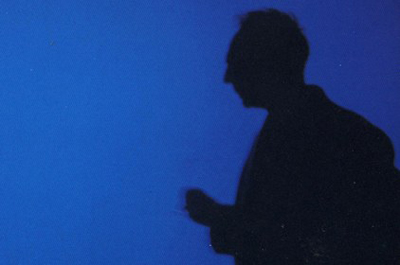An Examination of Derek Jarman’s Blue by Rebecca Sedehi

Jarman Blue
Rebecca Sedehi
Despite the separation that one might expect to feel in front of a vacant screen; the viewer is actually entrenched in Jarman’s emotional journey.
Composer Frederick Chopin wrote, “Simplicity is the final achievement. After one has played a vast quantity of notes and more notes, it is simplicity that emerges as the crowning reward of Art.” Blue, the last film by Derek Jarman chronicles Jarman’s experience of physical decay as complications from AIDS render him partially blind. While film is normally defined as a continuum of moving images, here the viewer is presented with an alternative approach; the screen is filled with a single shot of deep, radiant blue. The simplicity of this pure color functions as both a powerful backdrop and an empty space where the viewer is able to project his/her own images.
In this saturated field of color, the viewer is instantly reminded of Yves Klein’s renowned monochromatic blue paintings. Klein believed that, “The use of a single color, like the use of one note drawn out, creates a sense of the infinite, of continuous immaterial space, of which we are catching (or hearing) only a brief glimpse, a point of possible entry, a tiny invitation to experience, perhaps ever so slightly, the vast reality beyond what is visible.” Jarman was also deeply fascinated by the connection between mysticism and art and the monochromatic works of Klein affected him profoundly.
In 1974, after visiting an exhibit of Klein’s work at the Tate Gallery, Jarman was inspired to make a film dedicated to the artist. However, he did not pursue this idea until almost a decade later following his diagnosis of AIDS. At this point Jarman’s health was in rapid decline and his original concept for the film transformed into an intimate portrayal of his struggle with AIDS. Despite these thematic changes Jarman stayed true to his original concept by eliminating images, opting instead for one color (Yves Klein Blue) to create the “vast reality beyond what is visible.” Thus, Jarman’s “Blue” is simultaneously an autobiographical narrative and a tribute to Yves Klein.
Throughout the 79 minute soundscape several narrators (including Jarman) question and probe the philosophical and metaphysical meaning of blue through poetic descriptions and free association:
Blue of my heart
Blue of my dreams
Slow blue love
Of delphinium days
Blue is the universal love in which man bathes - it is the terrestrial paradise.
Here, blue is defined as an internal emotion that correlates to the infinite. Blue, followed by the words- heart, dreams, love and days conjures particular human experiences but are ultimately rooted in a universal language. Even more abstract phrases such as, “Blue bottle buzzing” or “blue canvasses fluttering in the wind….blue people from over the sea” ground the viewer by using words that reference ordinary things like “bottles”, “canvases” and “people.” At the same time Jarman’s use of the words “sea” and “wind” evoke the elemental and amorphous qualities of an unattainable space.
Though Blue is undoubtedly a film about death it succeeds in being more than a somber film. The narrator at once expresses both wonder and awe as he contemplates the unknowable and mysterious state of nonexistence.
“One can know the whole world
Without stirring
Without looking out the window
One can see the way of heaven
The further one goes
The less one knows”
Beauty reveals itself inside layers of sadness, anger and fear. The narrator longs for his former, vital self but gradually surrenders to the void, as death is inevitable.
“Impatient youths of the sun
Burning with many colours
Flick combs through their hair
In bathroom mirrors
Fucking with fusion and fashion
Dance in the beams of emerald lasers
Mating on suburban duvets
Cum splattered nuclear breeders
What a time it was.”
As the viewer is submerged in blue, a tapestry of sound is woven together with fragments of music and voices that collide with the banal, mechanical, noises of modern life. The monotonous drone of the hospital reiterates the strange and relentless embrace of death. Compelling metaphors such as “My retina is a distant Mars” and surreal statements like, “I’ve walked behind the sky,” create multiple reflections of illness and dying. Like Sigmund Freud’s “rules” for arranging patients away from himself during psychoanalysis to “avoid giving the patient material for interpretation” Jarmon’s positioning of the viewer in front of a blank blue screen allows one to form one’s own images through personal association and intuition. After all, Jarman is a patient himself during the film and his vulnerability and fear are palatable emotions that form the basis of the narrative. However, despite the separation that one might expect to feel in front of a vacant screen; the viewer is actually entrenched in Jarman’s emotional journey. Through the meticulous craftsmanship of sound, music and Jarman’s poignant narrative; the viewer’s senses are magnified transcending one's imagination into a visceral and emphatic experience.
Works cited:
http://www.brooklynrail.org/2014/04/film/fade-to-blue
http://www.queerculturalcenter.org/Pages/Jarman/JarmanBTx.html
http://thequietus.com/articles/05380-world-aids-days-simon-fisher-turner-on-derek-jarman-s-blue
Brougher, Kerry; Vergne, Phillipe; Ottman, Klaus, Yves Klein: With the Void, Full Powers, Hirshhorn Museum and Sculpture Garden/Walker Art Center, 2010
http://www.brainyquote.com/quotes/authors/f/frederic_chopin.html
Jarman, Derek, Kicking the Pricks, Univ Of Minnesota Press; Minnesota, 2010



